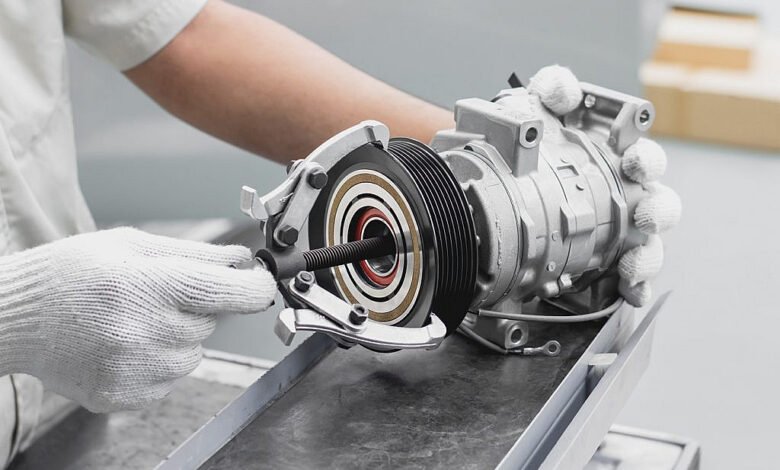How to Choose the Right Replacement Parts for Your Vehicle’s AC System

Your vehicle’s air conditioning system is a complex network of components working together to keep you cool and comfortable, especially during those hot summer drives. When one of these vehicle air conditioning parts fails, it can disrupt the entire cooling process, leaving you with a less efficient or non-functioning AC system. It’s tempting to jump straight into buying a replacement, but choosing the wrong component or low-quality part can lead to poor performance, frequent breakdowns, and costly repairs down the road. That’s why it’s crucial to understand the function and compatibility of each part before making a purchase.
Whether you’re a DIY enthusiast or planning to work with a mechanic, selecting the right replacement parts for your car’s AC system is crucial for long-lasting repairs and efficient cooling. This guide will walk you through essential tips on picking quality AC components, understanding the differences between OEM and aftermarket parts, and ensuring proper compatibility with your vehicle.
Understanding the Basics: Key Components of Your Vehicle’s AC System
Before diving into parts selection, it’s helpful to know the major components of your vehicle’s AC system:
- Compressor: The heart of the AC system that compresses and circulates refrigerant.
- Condenser: Cools the refrigerant from a gas to a liquid state.
- Evaporator: Absorbs heat from inside the cabin to cool the air.
- Expansion Valve or Orifice Tube: Regulates refrigerant flow into the evaporator.
- Receiver-Drier or Accumulator: Removes moisture and debris from the refrigerant.
- Control Valves and Sensors: Manage pressure and system operation.
- Refrigerant: The cooling fluid circulating through the system.
Any one of these parts can fail due to wear, leaks, or contamination, so knowing what you need is the first step.
Tip 1: Know Your Vehicle’s Make, Model, and Year
Your car’s AC system components vary significantly across makes, models, and production years. When shopping for replacement parts, having accurate vehicle information is essential. This ensures compatibility and avoids costly returns or mismatched components.
- Use your vehicle identification number (VIN) when possible to get precise part recommendations.
- Consult your owner’s manual or repair guides to identify part numbers or specifications.
- Check with trusted auto parts retailers or manufacturer websites for compatible parts.
Tip 2: Understand OEM vs Aftermarket Parts
One of the biggest decisions when replacing AC parts is choosing between OEM (Original Equipment Manufacturer) parts and aftermarket alternatives.
OEM Parts:
- Pros: Made by the vehicle’s manufacturer or approved suppliers, OEM parts match the original specifications perfectly. They offer reliability, fitment accuracy, and often come with warranties.
- Cons: Generally more expensive and sometimes harder to find, especially for older vehicles.
Aftermarket Parts:
- Pros: Produced by third-party companies, aftermarket parts are usually more affordable and widely available. They often come with improvements or enhancements over OEM.
- Cons: Quality varies widely between manufacturers. Some aftermarket parts may not meet exact OEM standards, leading to fitment issues or reduced lifespan.
How to Choose Between Them:
- For critical components like compressors or control valves, OEM parts are usually the safer bet due to the precision required.
- For simpler items like receiver-driers or expansion valves, quality aftermarket parts from reputable brands can provide good value.
- Always research brands, read reviews, and consult your mechanic before buying aftermarket.
Tip 3: Look for Quality Certifications and Warranties
When purchasing any vehicle AC part, check for certifications such as ISO 9001 quality management or industry-specific approvals. These indicate the part meets certain manufacturing and performance standards.
Warranties are another important consideration. Parts backed by solid warranties not only protect your investment but also reflect the manufacturer’s confidence in product durability.
See Also: How an Ecommerce Bookkeeper Can Help Scale Your Online Retail Business
Tip 4: Verify Compatibility and Fitment
Even if a part looks right, small differences can affect installation and performance. Some AC parts are designed for specific vehicle trims, engine sizes, or climate packages.
To avoid compatibility issues:
- Use online tools on parts retailer websites that allow you to enter your vehicle details to filter compatible parts.
- Cross-reference part numbers from your existing components or manufacturer catalogs.
- When in doubt, ask a professional mechanic or parts specialist for advice.
Tip 5: Consider the Complete AC System Health
Sometimes replacing just one faulty component isn’t enough. AC systems rely on the seamless interaction of all parts, so when one part fails, others might be stressed or damaged.
- Inspect related components: For example, if your compressor fails, check the condenser, receiver-drier, and refrigerant lines for wear or contamination.
- Flush the system: Removing old refrigerant and debris can prevent new parts from failing prematurely.
- Replace seals and O-rings: These small parts ensure a tight seal and prevent leaks.
Investing a little more in related parts and proper servicing can extend your new component’s lifespan and avoid recurring issues.
Tip 6: Don’t Forget Refrigerant Type and Specifications
Modern vehicles use different types of refrigerants (R134a, R1234yf, etc.), and AC parts are designed to work with specific refrigerants. Using the wrong parts or refrigerant can damage the system and void warranties.
Make sure replacement components are rated for your vehicle’s refrigerant type and follow manufacturer guidelines for refrigerant handling.
Bonus Tip: Work with Trusted Suppliers and Professionals
Purchasing AC parts from reputable suppliers ensures you get genuine, tested products. Avoid buying cheap, unbranded parts from unknown sellers, especially online marketplaces, as these may be counterfeit or low quality.
If you’re not comfortable installing parts yourself, working with experienced mechanics can save time and prevent mistakes. They can also help source the best parts and provide professional system diagnostics.
Final Thoughts: Smart Choices for Cool Comfort
Replacing parts in your vehicle’s AC system doesn’t have to be stressful or confusing. By understanding your vehicle’s needs, choosing between OEM and aftermarket wisely, verifying compatibility, and focusing on overall system health, you can enjoy reliable, efficient cooling for years to come.
Remember, your car’s air conditioning system is vital not only for comfort but also for safety, especially in extreme temperatures. Investing time and care into selecting quality replacement parts ensures you won’t be left sweating on your next drive.





